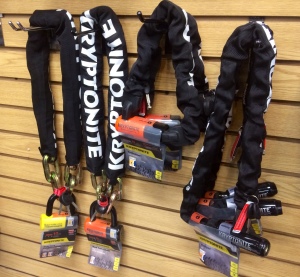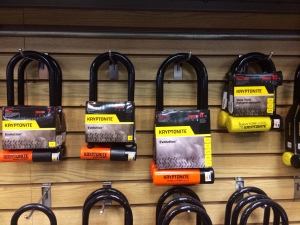Village Cycle and law enforcement agencies recommend securing your bike with a strong, secure lock. They acknowledge that locks will not prevent any determined thief from stealing your bike, BUT it will deter them in many circumstances by making it more difficult. Bicycle owners may be uncertain which bike locks offers the best protection.
 Chain With Padlock
Chain With Padlock
This type of lock contains a length of chain with either an integrated locking system or a separate padlock or mini D-lock. Secure the chain to itself by creating a “closed loop” around the bike frame, wheel(s) and an immobile object. These high-quality chains and locks are cumbersome and difficult or uncomfortable to carry. They are not easy to mount on a bike frame and you’ll oftentimes see bike commuters wearing these looped around their upper body while riding.
 D/U Locks
D/U Locks
These shackles have a D or U shape that locks into a “lock body.” The lock body houses the locking mechanism. These bike locks vary in length depending on their purpose. Hardened steel originally was used for D/U locks. Today they contain steel alloys that increase strength, while reducing weight. This locking mechanism is susceptible to levering, and it may become stiff from its exposure to the elements, so make sure to replace every few years.
 Cable and Coil Locks
Cable and Coil Locks
Cable locks have a diverse range of weights and strengths. The lock is a length of plastic coated steel cable in combination with an integrated or separate locking mechanism. Some common mechanisms include barrel, pin, key, and combination. Coil cable locks are “sprung;” they return to a coiled configuration when not stretched. These coiled cables are easier to carry, but typically use narrow gauge steel in its construction. We suggest using these as secondary bike locks for wheels or the saddle.
 Secure Skewers
Secure Skewers
These devices are an excellent option for replacing the quick release bolt fixings on wheel and seat posts. There are several designs available that offer varying degrees of protection. “Coded Keys” like the ‘Pinhead’ system that uses a small hand tool that is compatible with the ‘nuts.’ “Coded or Unusual Allen Key” uses a less common five-sided Allen Nut. Recessed and Collared ‘Nut’ Heads like ‘Pitlock’ use one of the 256 nut configurations. These bike locks protect components, like the saddle, not the frame.
Locking Your Bike With Two U-Locks
First position your bike against a fixed, immovable object. Put the 1st U-lock around the immovable object and through both seat stays. Place the 2nd U-lock around the immovable object and the downtube, including the front wheel, keyway facing down.
Locking Your Bike With a Chain
First position your bike against a fixed, immovable object that your bike can not be lifted over. Next remove your front wheel and place it beside your rear wheel. Wrap the chain through both wheels, around the frame and the fixed object. Make sure there is no chain slack. Attach a U-lock to connect the front wheel to the frame, for extra security. Lock your bike in well-lit areas.
A Word of Warning for Chicago
- Do not lock your bike to a street sign since most are held in place with a single bolt that is easily removed.
- Don’t use a tree to lock your bike to since most that you’ll find on sidewalks are skinny enough to be cut don in matter of minutes.
- Don’t lock your bike to a wooden railing, such as the ones you’ll find on the back entrances of many Chicago residential buildings since those railings are easily cut.
- Before securing your bike to any railing or fence look to make sure there aren’t any signs prohibiting you from doing so.
- Even though many have signs saying they were left for bikes to be locked to, don’t lock your bike to the old parking meter posts since those are short enough that a person could lift your bike off the post.





0 Comment